By Dan Kidder
Managing Editor
One often overlooked aspect of firearms practice is target selection. I can’t tell you how often I go to the range to see a motley assortment of pallets, carboard boxes, makeshift contraptions full of rocks, fence posts, and other assorted scavenged detritus that never seems to really perform all that well and causes the shooters to frequently have to suspend shooting to walk down and repair or re-setup their wonky target contraption that has collapsed.
There are literally tons of purpose-built target setups on the market that let you focus more on shooting and less on trying to jerry-rig something to shoot at. Let’s look at some of the options available and talk about the benefits of each.
Nothing gives you better feedback on accuracy than punching holes in a paper target. The paper records every shot and lets you make adjustments to your fundamentals accordingly. It is inexpensive, easy to set up, and my favorite paper targets of choice for pistol shooting are paper plates and 3x5 cards. But getting that paper to behave the way you want can be tricky, so some purpose-made target stands can be a big help in keeping that target where you want it and make it much easier to practice. My choice for a target stand is the Birchwood Casey Adjustable Steel Target Stand. I used to make target stands out of 2x4 lumber, but after years of use, they start to give you splinters, swell with changes in moisture, warp, and come apart at the screws. They were cheap and they worked, but they were not an ideal solution. And they were very bulky to store and transport. With the Birchwood Casey Steel Target Stand, I have a much lighter and more compact option. You simply use a pair of cut-to-length 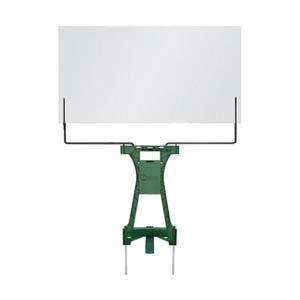 1x2 furring strips that you can pick up for about a dollar at most home improvement centers as the uprights. I take it a step farther and purchase a 2’ by 4’ handy panel of MDF for under $8 a sheet and screw it to the furring strips. This panel can take thousands of shots and gives me a backer to staple my paper or cardboard targets to. If the panel or the uprights wear out or get shot, then they are cheap and easy to replace. The Steel Target Stand also comes with two heavy steel pegs to drive into the ground through holes in the feet to keep your target upright in windy conditions, so it can be used in any weather. The best feature of this stand is that it can be adjusted to various widths with a set screw on the base and the ability to slide the upright supports closer together or farther apart and then lock them in position.
1x2 furring strips that you can pick up for about a dollar at most home improvement centers as the uprights. I take it a step farther and purchase a 2’ by 4’ handy panel of MDF for under $8 a sheet and screw it to the furring strips. This panel can take thousands of shots and gives me a backer to staple my paper or cardboard targets to. If the panel or the uprights wear out or get shot, then they are cheap and easy to replace. The Steel Target Stand also comes with two heavy steel pegs to drive into the ground through holes in the feet to keep your target upright in windy conditions, so it can be used in any weather. The best feature of this stand is that it can be adjusted to various widths with a set screw on the base and the ability to slide the upright supports closer together or farther apart and then lock them in position.
If the ground is soft enough, there are options like the Caldwell Ultimate Target Stand that drives into the ground on steel spikes. This doesn’t work for me at my rocky and hard packed dirt range, but would be great for a grassy field. It includes everything you need from the plastic backer to the steel uprights, and even includes a storage compartment to store items like staplers and target pasters.
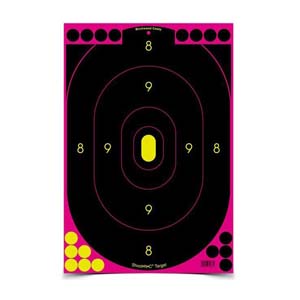
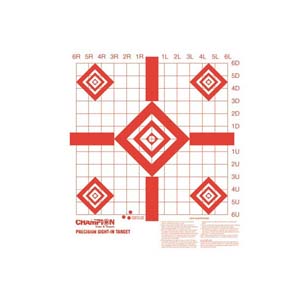
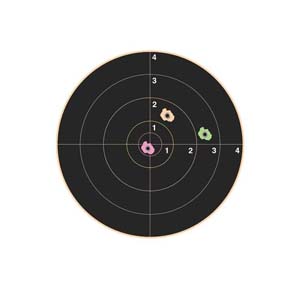 Once you have your method of standing your target up, you need to look at the various types of paper targets on the market. Let your purpose drive your selection. If you are practicing for defensive pistol, choose a human shaped target or an IPSC carboard competition target. For general marksmanship, a circular target would be fine. If you are trying to sight in an optic, a measured square sight-in target is going to give you the best information to make fast adjustments to the optic to get you zeroed more quickly. Depending on the distance I am shooting, I may choose a visible splatter target like the Champion VisiColor targets that use a printed coating over various colored backgrounds to let me clearly see my hits without walking down range.
Once you have your method of standing your target up, you need to look at the various types of paper targets on the market. Let your purpose drive your selection. If you are practicing for defensive pistol, choose a human shaped target or an IPSC carboard competition target. For general marksmanship, a circular target would be fine. If you are trying to sight in an optic, a measured square sight-in target is going to give you the best information to make fast adjustments to the optic to get you zeroed more quickly. Depending on the distance I am shooting, I may choose a visible splatter target like the Champion VisiColor targets that use a printed coating over various colored backgrounds to let me clearly see my hits without walking down range.
Reactive Targets
If you aren’t trying to see exactly where you are hitting, but just want to hit the target, a reactive target is a lot of fun to shoot and gives you that instant gratification of pinging steel or sending a rubber ball flying across the range. There are a variety of reactive targets that give you instant feedback that let you know you are scoring hits. One of my favorite, though fairly expensive, are pumpkins and watermelons.
 Steel targets come in a variety of shapes, sizes, and configurations. A stand to hold the steel target can be as simple as the Birchwood Casey 8-Inch Gong Target Kit. It features a stand that holds a single 2x4 wood post and has a steel mount that sits on top to hold the included 8-inch AR500 steel gong. It is set up to hang a target for movement or flipped around to bolt any steel plate at a 45-degree angle to the shooter so bullets deflect downward. It even has a spring to keep the bolt tight and also allow the target to flex when hit, reducing the amount of force transferred to your 2x4. I like to attach my Jumping Targets Mini IPSC AR500 steel target and just ring the steel. A fun transition drill is to set up two stands with the IPSC target and the other with the 8-inch gong and practice center mass followed by head shots on a second bad guy. This is a challenging and fun way to get faster at engaging multiple attackers.
Steel targets come in a variety of shapes, sizes, and configurations. A stand to hold the steel target can be as simple as the Birchwood Casey 8-Inch Gong Target Kit. It features a stand that holds a single 2x4 wood post and has a steel mount that sits on top to hold the included 8-inch AR500 steel gong. It is set up to hang a target for movement or flipped around to bolt any steel plate at a 45-degree angle to the shooter so bullets deflect downward. It even has a spring to keep the bolt tight and also allow the target to flex when hit, reducing the amount of force transferred to your 2x4. I like to attach my Jumping Targets Mini IPSC AR500 steel target and just ring the steel. A fun transition drill is to set up two stands with the IPSC target and the other with the 8-inch gong and practice center mass followed by head shots on a second bad guy. This is a challenging and fun way to get faster at engaging multiple attackers.
 For rifle shooting at long range, I love my Guns Gong Crazy swinging steel target gong and stand. This lets me set up my target at ranges out past 600 yards and the gong rings loudly when hit. It is an all-in-one stand with folding legs and a very stout AR500 steel gong suspended from Kevlar straps. The 18" gong also comes with a magnetic template to repaint target marks on the gong, so you can easily see where you hit based on the bullet splatter. This thing is super loud and can be heard from over a mile away, if you can hit it at that distance.
For rifle shooting at long range, I love my Guns Gong Crazy swinging steel target gong and stand. This lets me set up my target at ranges out past 600 yards and the gong rings loudly when hit. It is an all-in-one stand with folding legs and a very stout AR500 steel gong suspended from Kevlar straps. The 18" gong also comes with a magnetic template to repaint target marks on the gong, so you can easily see where you hit based on the bullet splatter. This thing is super loud and can be heard from over a mile away, if you can hit it at that distance.
Some things to keep in mind with steel targets is that each target is rated for specific calibers and bullets. It is important when selecting a steel target that you don’t use anything more powerful or a  bullet that is harder than the rating for that target. I have seen many steel targets that have been destroyed or damaged by using the wrong target with the wrong bullet. We even had some half-inch AR500 steel plates with multiple holes punched in them because someone borrowed them and used them incorrectly. Many are rated only for rimfire, and that means .22LR and .22 WMR. We have tested them with .17HMR, and these speedy little bullets damaged them.
bullet that is harder than the rating for that target. I have seen many steel targets that have been destroyed or damaged by using the wrong target with the wrong bullet. We even had some half-inch AR500 steel plates with multiple holes punched in them because someone borrowed them and used them incorrectly. Many are rated only for rimfire, and that means .22LR and .22 WMR. We have tested them with .17HMR, and these speedy little bullets damaged them.
Some of the dancing steel targets, such as the Jumping Targets, are shaped like a child’s jack and always lands with a target presented up. These bounce around the ground with each shot. They come in different sizes from small for rimfire to large for heavier rifles. They are a lot of fun and a real challenge to keep moving around.
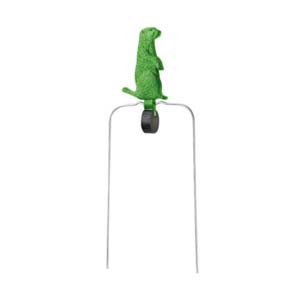 Another type of popular reactive target is self-healing polymer. These can be stuck in place on a stand or they can be hopping targets of various shapes. The stationary targets like the Champion DuraSeal targets will spin when hit. The material can take thousands of shots, but I will warn you that eventually you are going to strike the thin metal rods that hold the target and when you do, that target will be finished as the bullet will sever the rod. The flat-tipped soft metal rods are also difficult to drive into hard ground. Still, as long as they last, they are a lot of fun and come in various shapes from a gopher to a diamond.
Another type of popular reactive target is self-healing polymer. These can be stuck in place on a stand or they can be hopping targets of various shapes. The stationary targets like the Champion DuraSeal targets will spin when hit. The material can take thousands of shots, but I will warn you that eventually you are going to strike the thin metal rods that hold the target and when you do, that target will be finished as the bullet will sever the rod. The flat-tipped soft metal rods are also difficult to drive into hard ground. Still, as long as they last, they are a lot of fun and come in various shapes from a gopher to a diamond.
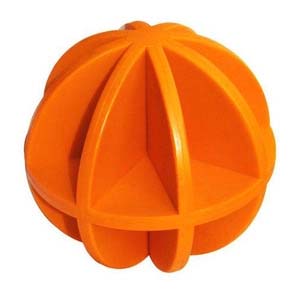 My favorite self-healing targets are ground bouncers like the Do-All Outdoors 4-inch Dancing Ball. These come in all kinds of shapes from squares to balls, to top hats, and they can go flying when you hit them squarely with a high-powered rifle. With a couple of them, it is fun to have a race with a buddy to see who can move their target across the finish line first. They never go in a straight line.
My favorite self-healing targets are ground bouncers like the Do-All Outdoors 4-inch Dancing Ball. These come in all kinds of shapes from squares to balls, to top hats, and they can go flying when you hit them squarely with a high-powered rifle. With a couple of them, it is fun to have a race with a buddy to see who can move their target across the finish line first. They never go in a straight line.
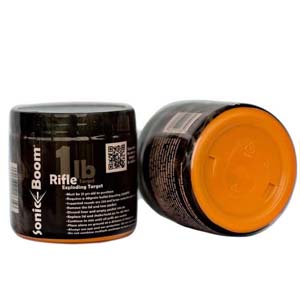 Lastly, one of my favorite reactive targets is the Sonic Boom binary exploding targets. These are a mix of two chemicals that when hit with a high-powered impact from a bullet explode in a flash of light, smoke, and a loud thump. Obviously, they are only good for a single hit. But they are far more fun to shoot than a watermelon.
Lastly, one of my favorite reactive targets is the Sonic Boom binary exploding targets. These are a mix of two chemicals that when hit with a high-powered impact from a bullet explode in a flash of light, smoke, and a loud thump. Obviously, they are only good for a single hit. But they are far more fun to shoot than a watermelon.
With so many options on the market to choose from, there is no reason to cobble together some improvised contraption. Hit your local Sportsman’s Warehouse and browse their huge selection of targets and spend more time shooting and less time messing around with an inadequate target. Shoot often, shoot safe, and have fun.


